What is Remediation: Terminology and Approaches (Part 1)

In this series of articles, we explain some basic remediation terminology and different approaches as well as offer a response to the common question of remediation cost. This information will be useful to those who are looking for preliminary and “ballpark” estimates for timelines and site cleanup costs.
For a consultant who specializes in site remediation, it is not uncommon to receive an email or call from a (prospective) client along the lines of:
We are concerned that our site has an ongoing leak of hydrocarbons (and/or some other products or chemicals) from an underground storage tank (and/or waste storage area, refueling area, pipeline, etc.) and suspect that this may be seeping into the underlying soils and groundwater.
Can you help?
We of course answer - “Certainly, we can help” - and then explain the numerous tasks associated with typical remediation projects - preliminary risk/scoping assessments, site investigations, risk assessment, feasibility study, remedial action plans, dealing with local regulators, carrying out site remediation, closure/completion requirements.
Remediation Definitions: What is That?
Before we get to the hard numbers (i.e., dollars, euros, pounds, riyal, dinar…), let’s discuss terminology and what we actually mean when we’re talking about contamination, remediation, and approaches to investigating and carrying out remedial actions. In this first article of the series, let’s talk terminology and one example of a typical course of action.
What is a Contaminated Site
A contaminated site is one at which levels of some contaminant, typically a chemical (e.g., benzene) or a mix of chemicals (e.g., diesel fuel), found in the soil, water or air at the site are potentially harmful to people or living organisms.
What is Remediation
Remediation is the process of minimizing the harmful effects of contamination to people and the environment, by removing the contaminant (e.g., by excavating contaminated soil for off-site treatment/disposal) and/or by reducing contaminant levels (e.g., by chemical amendments) to an acceptable level that is safe for people and the environment.
How “Clean” is Clean
An important aspect of remediation is reducing contaminant concentrations to levels below which the site is deemed “clean”, but the definition of what is meant by “clean” is not always straightforward.
For mixtures of chemicals and less common contaminants, there may be no regulatory standards or guidelines; in those cases, the consultant may need to develop such criteria, for example, using toxicological data and risk assessment approaches (more on that later).
Phased Approach to Remediation
Most remediation projects are by necessity executed in a multi-phase extraction methods, generally with incremental increases in costs as we move through the phases of a typical remediation project:
Typical Steps in Site Remediation Project - Relative Cost, in brackets, as a Percentage of Total Cost
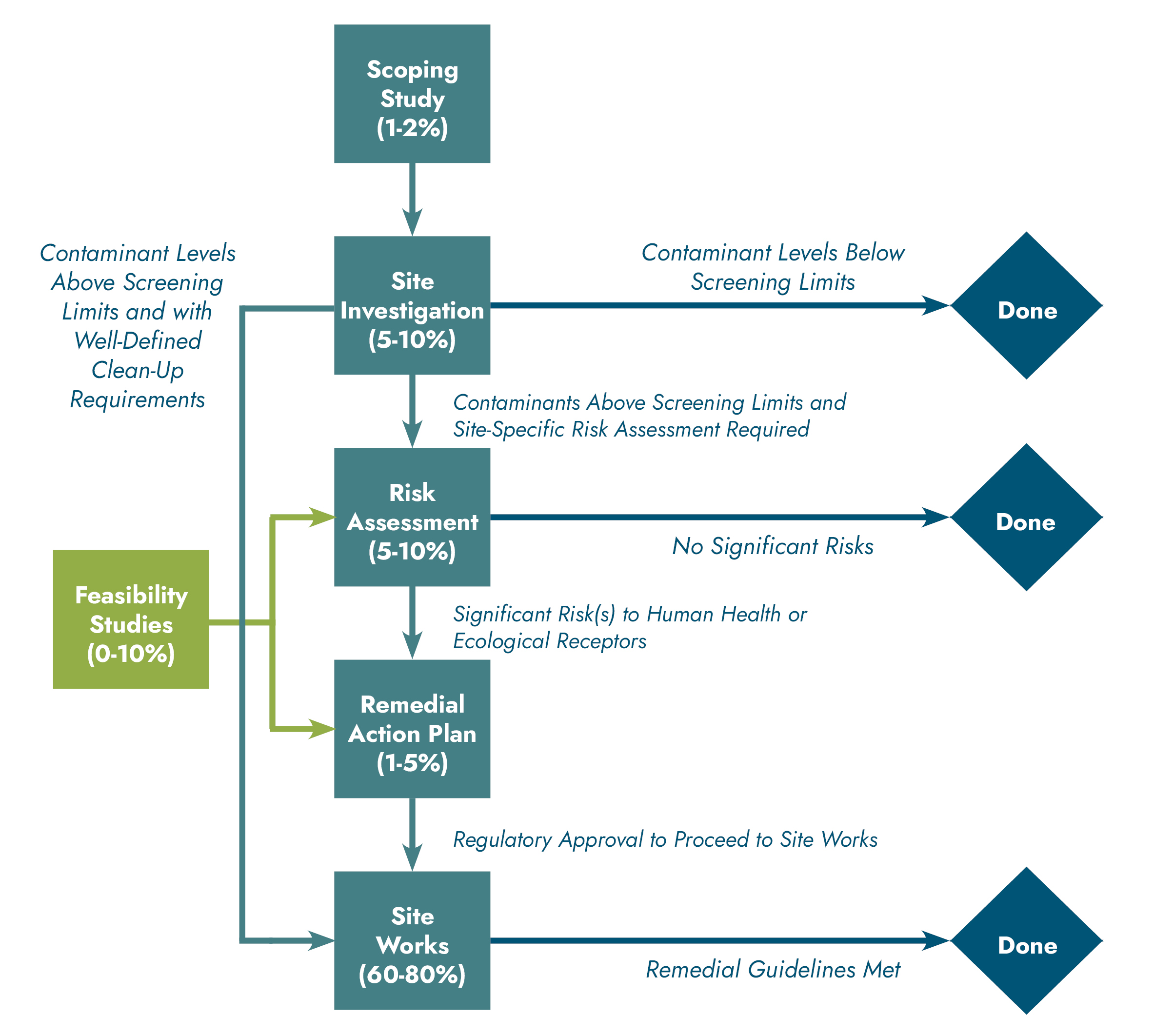
1. Scoping Study
The first step for most remediation projects is to carry out some sort of scoping study, which uses already available information to provide an overview of site conditions, issues and a general plan for project phases. This may be done as a desktop study, or if more information is needed, with the addition of a site visit or meetings with key stakeholders. A typical scoping study can be completed in one to two weeks.
The main outcome here is a Scoping Report that summarizes available information, site conditions and sampling plan for site investigation.
2. Site Investigation
Typically, site investigation work includes sampling soils, soil vapor and/or groundwater. These investigations can take from one day (e.g., in the case of a single spill from a fuel tank) to weeks or months (e.g., multiple sources of contaminants and where groundwater contamination has migrated far from the sources).
Also, be forewarned, it is not uncommon to find additional issues during the site investigation phase (such as contaminants not initially anticipated, soils or groundwater contamination that extends greater than originally anticipated), or for a second round of sampling to be required to better characterize the contamination.
The resulting Site Investigation Report is extensive and includes:
- data tables
- figures showing the extent of contamination both across the site and in deeper soils or groundwater
- assessment of measured levels against screening criteria
- identification of potential site contaminants
- assessment of contaminant plumes
- recommendations for further work, such as feasibility studies or risk assessment if and as required.
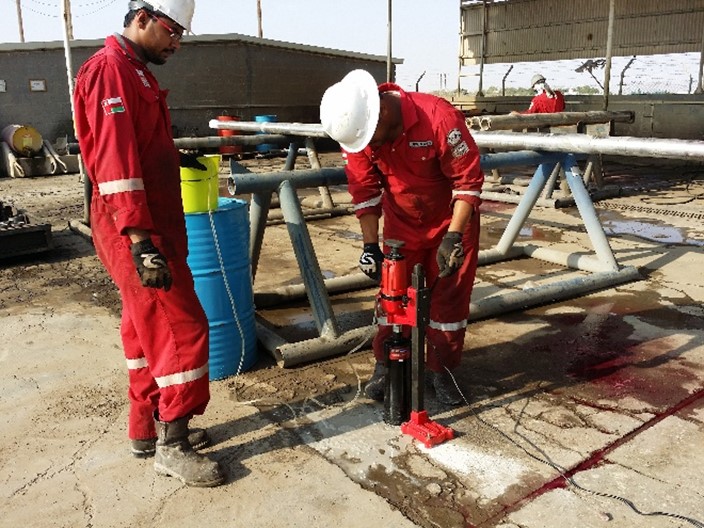
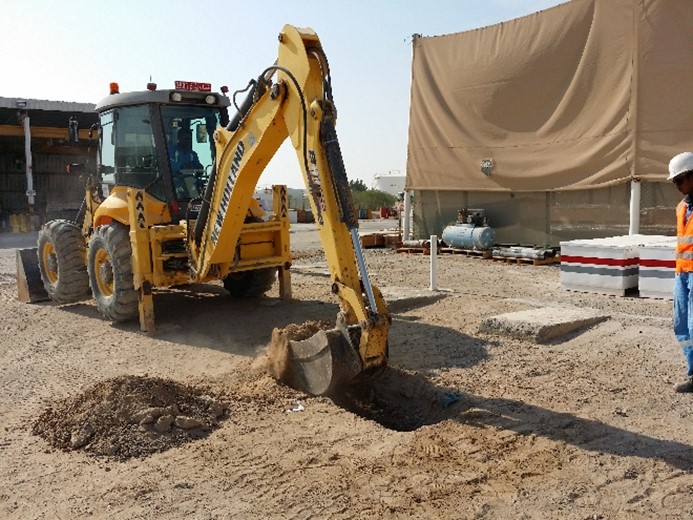
Site Characterization of Contaminated Site, Oman
3. Feasibility Study
Once it is clear that remediation is indeed required, there may be a need, especially in more complex sites, for feasibility studies to assess the potential effectiveness of different remediation techniques and technologies. This may include bench-scale and pilot-scale tests of different amendments for bioremediation, modeling studies of potential groundwater plume migration with different pumping/treatment approaches, deriving detailed cost estimates for different approaches and more.
Feasibility studies can take weeks or months to complete - the latter if bench-scale and/or pilot-scale tests truly are needed. The results of these feasibility studies feed directly into the risk assessment and remedial action plan phases.
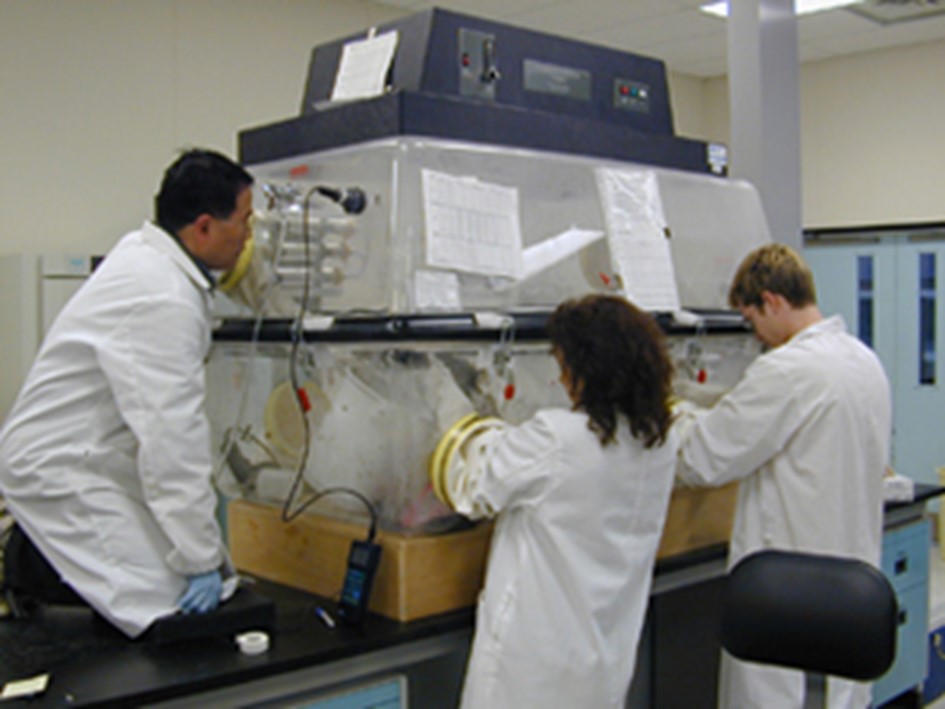
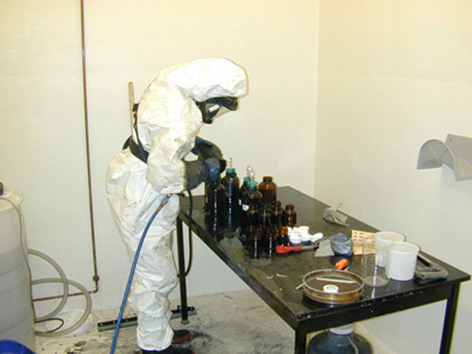
Bench-Scale Tests of Amendments of In Situ Bioremediation of Contaminated Shoreline in Kuwait
4. Risk Assessment
A site-specific risk assessment is a well-defined process of characterizing risks to people and the environment associated with exposure (e.g., via inhalation) to site contaminants (e.g., benzene, etc) via various pathways (e.g., contaminants migrating below the water table into groundwater and vapor intrusion). Risks can be quantified against various endpoints (such as an incremental risk of cancer, in case of a carcinogen like benzene) and for various scenarios (current; future if nothing is done; future if different types of remedial actions are employed). Risk assessments typically take a few weeks to complete.
Site specific risk assessments provide a means to develop credible site-specific clean-up criteria that are often less restrictive than generic standards, thereby reducing remedial works costs while still providing an adequate level of protection to human and ecological receptors. The Risk Assessment Report provides details of the risk calculations and can include the potential cost-benefit of various remedial measures, in terms of acceptable levels of risk reduction vs cost.

(Note: from Delta-Simons website https://www.deltasimons.com/services/geo-environmental/)
5. Remedial Action Plan
A Remedial Action Plan (RAP, or similarly named document) is a requirement in many jurisdictions and must be submitted to the authority and approved prior to starting remedial works. There are different forms and requirements for an RAP but all typically include details on conditions and types/levels of contaminants at the site, how the contaminants will be remediated, and a timeline/milestone plan for progress assessment. These documents can take many forms depending on the complexity of the site and methods, from a simple form to many pages of text, data, figures, etc.
The RAP timeline can generally be measured in days to weeks, as it is primarily a synthesis of already gathered information. However, the review process by the regulators can be unpredictable and can take an undetermined amount of time, the more if the site is high profile, complex, and/or requires non-standard remedial approaches.
6. Site Works
Site Works are an essential part of any environmental remediation process as they ensure that the site is safe for the environment and human health. Site Works can range from short-term projects to long-term efforts, depending on the nature and extent of contamination.
The timeline for Site Works will vary depending on factors such as the:
- size of the area
- type and amount of contaminants present
- complexity of required remedial activities
- availability of resources to complete the work
Often, the project will need to be broken down into individual components so each can be addressed separately.
Site Works must take place after the review process is complete in order to ensure all necessary requirements are met. Once the Site Works are completed, a final site assessment is performed to ensure that all remedial goals have been met. This process can be lengthy and costly if not done properly, so it is important to understand the full extent of contamination before starting the project.
Categories of Environmental Remediation
OK, so the pre-work is done and now the “real“ work can start. As with many of the processes mentioned above, there are multiple ways this can go. For ease, I have divided the types of environmental remediation into three broad categories:
1. Do Nothing
2. Removal and Disposal
3. On-Site Treatment
Do Nothing
How can “doing nothing” be classed as remediation? Well, believe it or not, this is an accepted remediation measure in many jurisdictions. By “doing nothing” what we actually mean can be called “natural attenuation” - a natural process(es) that results in the reduction in mass, toxicity, mobility, volume and/or concentration of contaminants in the environment.
Given enoughtime, this can lead to reducing contaminant levels to meet necessary standards. This approach could include additional measures, such as the placement of engineering measures and preventing access to the contaminated area by fencing. It can also include administrative measures, such as placing land-use restrictions on the site until levels of contaminants meet criteria.
This obvious advantage of this approach is that it is generally by far the cheapest, and allows time to degrade toxic organic compounds. The disadvantage, however, is that this approach also generally requires the longest time frames, perhaps several years or even decades for these natural processes to act on the contaminants to reach acceptable levels. There is also a risk, even if relatively low, that the regulators may in the future change the cleanup criteria so that natural attenuation would not be sufficient over the required timeframe.
Removal and Disposal
This approach is straightforward - remove the contaminants from the site via excavating soils and/or pumping groundwater, and then truck the contaminated soils and/or groundwater off-site for disposal at an appropriate facility. This is particularly useful for smaller sites or those with ready access to hazardous waste treatment/disposal facilities. Timeline wise, this will require from days to weeks for soils and many months to years for groundwater.
This key advantage of this approach is the removal of contamination from the site, and transferring liability to the treatment/disposal facility.
On-Site Treatment
An in-depth discussion of remediation technologies is well beyond the scope of an article - a dissertation or several could be written about any single remediation technology - and there are many different ones to choose from too. For example, the US Federal Remediation Technologies Roundtable’s (FRTR) Remediation Technologies Screening Matrix and Reference Guide lists 64 different technologies for groundwater or soil remediation. Each technology has a role depending on the type(s) of contaminant(s), site characteristics, clean-up goals, time constraints, logistic constraints, regulators, and other factors.
Examples of Common Remediation Technologies Include:
Groundwater Contamination
- Pump and Treat
- Chemical Oxidation
- Biological Amendment
- Permeable Reactive Barriers
- Air Sparging
Soil Contamination
- Capping
- Biopiles / Landfarming
- Chemical / Biological Amendment
- Phytoremediation
- Soil Washing
- Thermal
- Soil Vapor Extraction
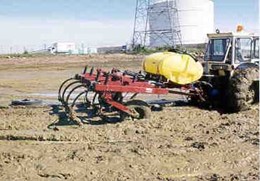
Amendment Injection for Treatment of Hydrocarbon-Contaminated Intertidal Sediments, Kuwait
Site remediation can take months or years to completely reduce contaminants to acceptable levels.
As mentioned above, there are advantages and disadvantages to each type of site remediation. A consultant could better expand on those that relate to a specific site - your site.
Hopefully, the information in this article provides a starting point to better understand the general remediation process. In the next article of this series we will address the all-important question of cost.
If you have any comments or questions related to remediation, please feel free to contact me, our Global Remediation Working Group or any of my Inogen Alliance colleagues across the globe. We are here to help you.
For support on Remediation, reach out to our team of experts today.
Inogen Alliance is a global network made up of dozens of independent local businesses and over 5,000 consultants around the world who can help make your project a success. Our Associates collaborate closely to serve multinational corporations, government agencies, and nonprofit organizations, and we share knowledge and industry experience to provide the highest quality service to our clients. If you want to learn more about how you can work with Inogen Alliance, you can explore our Associates or Contact Us. Watch for more News & Blog updates here and follow us on LinkedIn.
Randall D. Shaw, Ph.D.
Managing Director at Redlog Project Management Services LLC
Dr. Randall Shaw is Managing Director of Redlog Project Management Services LLC and is located at the Redlog regional HQ in Dubai, UAE. Dr. Shaw has a wide-ranging background in health, safety and environment, with a focus on those HSE issues faced by industry across the Middle East. Dr. Shaw’s blog posts on HSE issues are based on his experience from working in more than 40 countries, his pragmatic approach to solving HSE problems, and his desire to pass on this knowledge to others. Ultimately, his goal is to help HSE professionals and companies active in the developing world tackle their HSE issues. You can find him on Twitter (@RedlogHSE) and LinkedIn and he is always keen to discuss HSE issues with others.